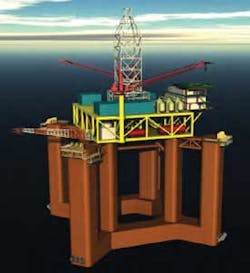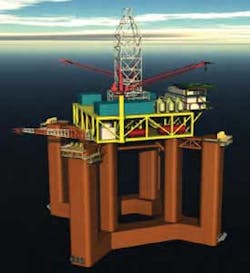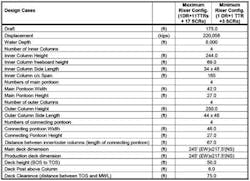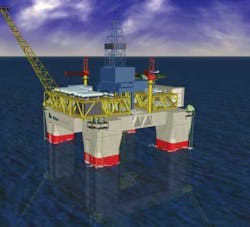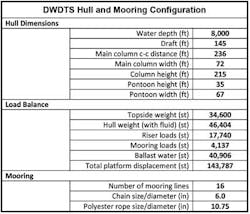Feasibility study assesses two dry tree options for the Gulf of Mexico
Roy Long
National Energy Technology Laboratory, US Department of Energy
Operators in the Gulf of Mexico (GoM) are increasingly looking to ultra-deepwater (>5,000-ft-1,524 m water depth) fields and more challenging reservoirs to deliver the hydrocarbons that the energy market demands and to satisfy their production growth objectives.
These deep subsalt reservoirs frequently have complicated issues, including additional required drilling, more complex completions, artificial lift requirements, and workover/intervention complexity.
These issues point to the use of dry trees as the most economical solution. In many cases, the depth of the reservoir requires a large drilling rig and drilling variable payload, resulting in very large topsides which challenge the limits of current spar technology.
Project overview
DNV GL was granted an award by the Research Partnership to Secure Energy for America (RPSEA), partially funded by the US Department of Energy's National Energy Technology Laboratory, to manage a project to develop dry tree semi concepts for the ultra-deepwater fields in the GoM. DNV GL's role in this project was twofold:
- To manage, on behalf of RPSEA, further development of two semisubmersible concepts suitable for drilling and production in the GoM ultra-deepwater, using dry trees.
- To act as an independent third-party verification agent for assessing the maturity of all safety and environmentally critical aspects of the concepts so that they are "project-ready" in the Gulf of Mexico.
Under the aegis of this project, two previously developed dry tree semisubmersible concepts were further matured for operation at 8,000-ft (2,438 m) water depth in the GoM:
- Paired Column (PC) semisubmersible developed by Houston Offshore Engineering (HOE)
- Deepwater Dry Tree Semisubmersible (DWDTS) developed by Kvaerner Field Development (KFD).
Both concepts had previously gone through some development (i.e., previous RPSEA funded projects, DeepStar funded projects, etc.). The current RPSEA project focused on critical design elements identified in the earlier work. In evaluating the designs, DNV GL endeavored to ensure that both concepts were developed in accordance with the same design basis. Of course, each design has its own unique challenges, which have been the focus of DNV GL's evaluation.
In previous projects, the following elements were identified as the most critical issues for each concept:
- Vortex-induced motion (VIM) and quayside integration for the HOE PC semi concept
- Riser tensioner qualification for the Kvaerner DWDTS concept.
Both concepts underwent VIM model tests and extensive engineering work. DNV GL conducted AiP evaluations for both concepts and TQ for each riser tensioning system. DNV GL concluded that the above critical elements have been adequately addressed for the purposes of conceptual design. Therefore both concepts are considered feasible, and can be regarded as "project ready," provided all comments and suggested actions in this report are properly addressed in the next project phase (e.g. FEED).
This project involved a large number of subject matter specialists from the industry and from DNV GL in key steps during design basis assessment, progress review, model tests, and final Conceptual Hazard Identification (HAZID) workshops. Throughout the project, the objectives have been to ensure that the concepts (1) are in line with industry practice and (2) meet the requirements for safe operation in the GoM. The discussion that follows is an update on this project, completed in December 2014 and originally discussed in Offshore in June 2012.
Dry trees for the Gulf
GoM dry tree solutions have been dominated by spars and tension leg platforms (TLPs). For water depths beyond about 6,000 ft (1,828 m), the TLP typically becomes cost prohibitive. For large payload systems, especially those requiring large drilling payload, the spar size, transportation options, and offshore installation become a challenge. The semisubmersible vessel offers several advantages over the spar option, including larger deck space and the possibility of quayside topsides installation and integration. It is expected that the dry tree semi will be cost competitive with the spar in most cases and will overcome the size limitations of the spar option.
The industry has shown significant interest in developing a dry tree semi solution over the last few years to increase contracting options. However, there remains an uncertainty about the total system maturity, constructability, performance, and cost efficiency. So far no dry tree semi has been selected as a host platform for large payload systems in ultra-deepwater.
Objective
Building on recent development of dry tree systems, this project is aimed at delivering project-ready and cost competitive dry tree semi solutions for the GoM in a minimum of 8,000-ft (2,438-m) water depth with drilling and production capabilities for moderate to large payloads.
The objective has been to consider two promising hull forms with the associated riser tensioning systems that make use of conventional technologies to the greatest extent possible. Key technical challenges and/or new technologies, which require qualification before being field ready, are to be addressed with associated technology qualification plans developed.
The study also identified deployment opportunities associated with each solution with respect to field applications and considerations for overall safety, equipment limitations, fabrication, transportation, installation, and geographical locations.
Scope of work
RPSEA selected two awardees (KFD and HOE) for this study, each with its own unique hull form. Each awardee was tasked with providing a hull form and associated riser tensioning systems, while making use of conventional technologies to the extent possible. The work requires performing pre-front-end engineering and design (pre-FEED), equivalent engineering, and cost estimates. RPSEA also selected DNV GL to manage the project and to act as an independent third-party verifier for assessing the maturity of all safety and environmentally critical aspects of the concepts.
For the HOE concept, the following key issues were addressed:
- Vortex-induced-motion (platform behavior when subjected to high currents) – model test
- Qualification of riser tensioner equipment (confirmation by equipment suppliers that the forces, moments, and strokes are within the capacity of existing off‐the‐shelf tensioner equipment, and further design of the tensioner system including keel guide)
- Feasibility of quayside integration and transportation
- Evaluate the design basis for safe operation in the GoM, update the design configurations if needed, and perform engineering analysis accordingly
- Further engineering work and pursuit of an approval-in-principal by DNV GL
For the Kvaerner concept, the following key issues were addressed:
- Further engineering with appropriate documentation of the conceptual design, including hull global design, airgap, stability, mooring, and riser configuration
- Evaluate the design basis for safe operation in GoM, update the design configurations if needed, and perform engineering analysis accordingly
- Further enhancement of structural design of riser interfaces with topsides and hull structures
- Qualification of the tensioning system:
- --Analyze structural integrity and stability of riser tensioning system
- --Perform a scaled model test of riser tensioner
- --Conduct a technical qualification of the riser tensioner system
- Perform a scaled model test of hull VIM
- Pursue an AiP evaluation by DNV GL.
Methodology
HOE and KFD further developed their dry tree semi concepts based on the scope defined in the proposal. The working project group (WPG) was established at the very beginning of the project. The WPG consists of subject matter specialists from the industry and DNV GL as well as the RPSEA project manager. Periodic WPG meetings have been arranged by DNV GL to review progress and seek input from subject matter specialists.
DNV GL used AiP as an approach to evaluate the overall concept feasibility. AiP is a typical process used for a class project to assess early conceptual feasibility. For this project, some design aspects that are beyond typical class scope but considered to be critical for dry tree semi concept (e.g. quayside integration) were also included in the evaluation. DNV GL also used its technology qualification (TQ) process for the riser tensioner qualification. Details of the AiP and TQ processes are described below.
Approval-in-principle
AiP is a structured process used by DNV GL to carry out an independent assessment of a concept within an agreed requirement framework. The aim of the AiP assessment is to confirm that the design is feasible and that there are no insurmountable obstacles ("showstoppers") that would prevent the concept being realized. AiP is particularly useful to assess novel designs which will not be adequately addressed by existing recognized codes and standards.
The AiP approach is a risk-based approach, which is considered to be the most effective means of identifying and addressing hazards associated with a novel concept. Such hazards may arise from use of novel technology (or operation), from a novel application of existing technology and from an interface between novel and existing technology.
Identifying these areas is a key part of the AiP process, which is, initially, intuitive and, subsequently, part of a structured iterative process. Having identified hazards (or critical elements) to be further addressed, the AiP process will assess how the designer has addressed these concerns. Typically the designer will carry out risk and engineering studies to document the probability and consequence associated with the hazards and the effects of mitigation measures proposed.
The AiP process will review documentation produced in the risk assessment, will confirm that all considered risks have been adequately addressed, and that mitigation measures are considered appropriate. Compliance with relevant prescriptive requirements will also be considered. Depending on the design concept and its intended application, it may also be appropriate to consider any regulatory barriers which might impact the design. In addition, actions to be taken toward full classification will be listed.
As part of AiP process, conceptual HAZID workshop(s) should be held with subject specialists and the designers. Unlike a typical design HAZID, this conceptual HAZID is similar to a peer review workshop, which identifies potential challenges and risks of a concept. This would typically involve qualified personnel from DNV GL who would facilitate the workshop, together with a team of designer's specialists, industry subject matter specialists, and DNV GL specialists with experience in the design and intended operations.
This workshop would focus on critical design elements and systematically discuss the potential risks of the design concept. The intention is to identify potential showstoppers, identify design novelties (new technology or new application of existing technology), systematically assess "what if" scenarios of the identified elements to evaluate potential failure mechanism and consequences of failure, discuss mitigations/improvements, and thereafter determine the feasibility of the concept.
Technology qualification
The TQ process is defined as a "Qualification Procedure for New Technology." It is a procedure developed as part of the DEMO 2000 project funded by the Research Council of Norway. The Recommended Practice was developed to cover the need for a systematic approach to qualify new technology and ensure that the technology functions reliably within specified limits.
Design basis
DNV GL, in close collaboration with the WPG group, performed a comparison of the original design basis used by each designer. Some discrepancies and ambiguities were found, e.g. metocean data, acceptance criteria, etc. Some comments were raised on living quarter capacity, SCR configurations, etc. As an example, the definition in the original design basis did not seem to be practical for a safe operation in the GoM. Based on the above findings and comments received, updates were made to the design basis in order to develop the concepts for safer operations in the GoM. These updates resulted in additional design iterations and some extra engineering work.
HOE dry tree semi
The HOE PC Semi has two columns in each corner, which are connected by pontoons. The PC Semi configuration is different from a conventional deep draft semi in three aspects:
- Eight versus four columns
- Rectangular column versus square column
- Larger column slenderness ratio.
KFD dry tree semi
The DWDTS hull is built on a conventional deepwater semisubmersible concept with four corner columns and a ring pontoon. The hull size is 308 ft by 308 ft (93 m) and the total height is 215 ft (66 m). The proposed draft is 145 ft (44 m). Freeboard is 70 ft (21 m) to the bottom of the deck box and 105 ft to the top of the deck box from mean waterline. The mooring system of the DWDTS consists of 16 mooring lines clustered in four groups (4x4) with chain-polyester rope-chain segments for each line.
The topside facilities are modularized and supported by a deck box structure with overall dimensions 254 ft (77 m) long (EW), 354 ft wide (108 m), and 35 ft (11 m) deep. The process module is on the north side of the deck and the living quarter is on the south end. The well-bay is arranged in the center of the deck to accommodate production and drilling systems.
Concept evaluation
This project engaged subject matter specialists to evaluate the concepts starting from establishing the design basis, to model tests and conceptual HAZID workshops. A WPG was established in the very beginning of the project to engage subject matter specialists from Chevron, ConocoPhillips, Statoil, Total, Marathon Oil, and RPSEA. WPG meetings were held on regular basis (every 1- 2 months) until the final workshop was conducted. The project participants (DNV GL, HOE, and KFD) also published several papers and held presentations at OTC Houston, OTC Brazil, and RPSEA conferences.
The objective of such industry participation and publication was to seek advice and feedback from the subject matter specialists and end users to ensure that concept development is in line with industry practice, and meets the requirements of a safe operation in the GoM.
